IASbaba's Daily Current Affairs Analysis
Archives
(PRELIMS & MAINS Focus)
Syllabus
- Prelims – Science and Technology
Context: The 8th edition of the India International Science Festival (IISF) was recently inaugurated at the Maulana Azad National Institute of Technology (MANIT), Bhopal, Madhya Pradesh.
- The theme of the four-day festival is “Marching towards Amrit Kaal with Science, Technology, and Innovation”.
About IISF:
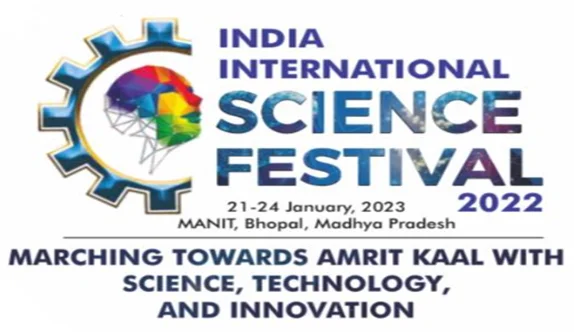
- India International Science Festival (IISF) is an initiative of Ministry of Science and Technology and Ministry of Earth Science of Government of India in association with Vijnana Bharati which is a science movement with Swadeshi spirit lead by eminent scientists of the country.
- The main purpose of IISF is the celebration of science by all.
- Through its creative programs and activities, IISF provides opportunities to people and scientific fraternity in the country and abroad to come together, work together and experience the joy of doing science for the well-being of India and humanity.
- The theme of this year mission is aligned with Prime Minister Narendra Modi’s vision to build a Self-reliant India and is also aligned with the G20 vision, which is Vasudhaiva Kutumbakam or “One Earth· One Family · One Future”.
- IISF will feature 14 thematic events:
- Students Science Village
- Face to face with New Frontiers of Science & Technology
- Science through Games & Toys
- Students Innovation Festival
- Vaigyanika (Literature)
- International Science Film Festival
- Guinness World Records attempts
- Artisan’s Technology Village-Vocal for Local
- Young Scientist Conclave
- New Age Technology Show
- National Social Organisations and Institutions Meet (NSOIM)
- STEM @ 2022-Mega Science and Technology Exhibition
- Start-up Meet
- Science and Technology Council Conclave.
Source: DownToEarth
Previous Year Questions
Q.1) With reference to recent developments regarding ‘Recombinant vector Vaccines’, consider the following statements:
- Genetic engineering is applied in the development of these vaccines.
- Bacteria and viruses are used as vectors.
Which of the statements given above is/are correct? (2021)
- 1 only
- 2 only
- Both 1 and 2
- Neither 1 nor 2
Q.2) With reference to the recent developments in science, which one of the following statements is not correct? (2019)
- Functional chromosomes can be created by joining segments of DNA taken from cells of different species.
- Pieces of artificial functional DNA can be created in laboratories.
- A piece of DNA taken out from an animal cell can be made to replicate outside a living cell in a laboratory.
- Cells taken out from plants and animals can be made to undergo cell division in laboratory petri dishes.
Syllabus
- Prelims – History and Art and Culture
Context: Recently, the Union Government has decided to nominate Assam’s Charaideo Maidams for the UNESCO World Heritage Centre.
Charaideo Maidams:
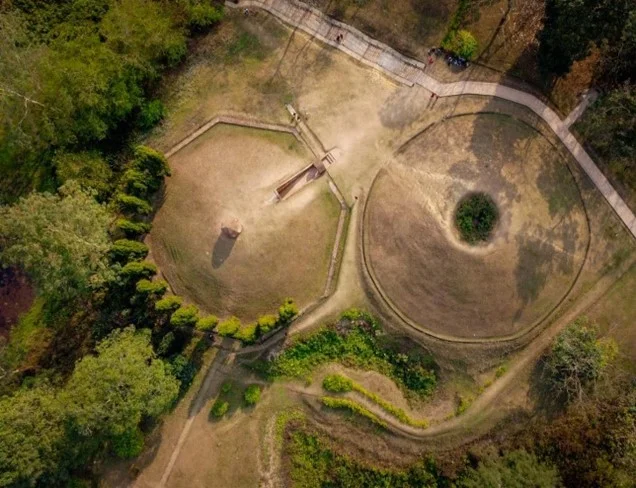

- Assam’s Charaideo Maidams are the Ahom equivalent of the ancient Egyptian pyramids.
- The maidams represent the late medieval (13th-19th century CE) mound burial tradition of the Tai Ahom community in Assam.
- The Charaideo Maidams enshrine the mortal remains of the members of the Ahom royalty, who used to be buried with their paraphernalia.
- Out of 386 Maidams or Moidams explored so far, 90 royal burials at Charaideo are the best preserved, representative of and the most complete examples of mound burial tradition of the Ahom’s.
- After the 18th century, the Ahom rulers adopted the Hindu method of cremation and began entombing the cremated bones and ashes in a Maidam at Charaideo.
Significance:
- There is currently no World Heritage Site in the category of cultural heritage in the northeast.
- The nomination of the Charaideo Maidams has attained significance at a time when the country is celebrating the 400th birth anniversary of Lachit Barphukan.
Ahom Kingdom:
- The Ahom dynasty was founded by Chao Lung Siu-Ka-Pha in 1253.
- The Ahom rule lasted for about 600 years until the British annexed Assam in 1826.
- Charaideo, more than 400 km east of Guwahati, was the first capital of the Ahom dynasty.
About Lachit Borphukan
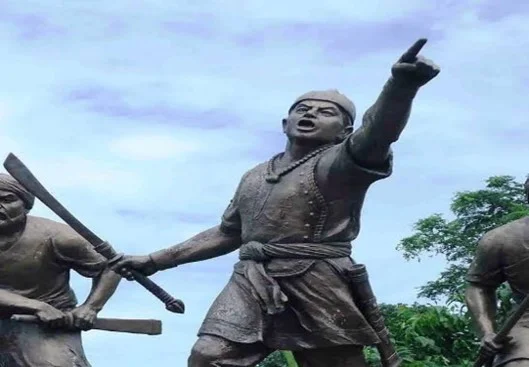
- Born: on November 24, 1622 in Charaideo, the first capital of the Ahom kings.
- Death: 25th April 1672.
- Excelled in the art of Guerrilla Warfare.
- Led two battles against an alien Mughal army.
Battle of Alaboi:
- Fought on August 5, 1669 in the Alaboi Hills near Dadara in North Guwahati.
- Aurangzeb had ordered the invasion in 1669 under his ally Rajput Raja Ram Singh I who led a combined Mughal and Rajput army.
- Borphukan engaged in guerrilla warfare, assaulting the invaders and then falling back until Ram Singh I unleashed his entire forces on the Ahom’s, defeating them in the Battle of Alaboi.
Naval battle in Saraighat in 1671:
- Lachit Borphukon’s valorous leadership led to the decisive defeat of the Mughals.
- According to historical accounts, Lachit is said to have tricked the Mughals by feigning an attack in front.
- As the fleet advanced on the river Brahmaputra, the main Ahom fleet attacked from behind, sealing a victory for the locals.
Source: The Hindu
Previous Year Questions
Q.1) With reference to Indian history, consider the following statements:
- The Dutch established their factories/warehouses on the east coast on lands granted to them by Gajapati rulers.
- Alfonso de Albuquerque captured Goa from the Bijapur Sultanate.
- The English East India. Company established a factory at Madras on a plot of land leased from a representative of the Vijayanagara empire.
Which of the statements given above are correct? (2022)
- 1 and 2 only
- 2 and 3 only
- 1 and 3 only
- 1, 2 and 3
Q.2) With reference to the history of India, “Ulgulan” or the Great Tumult is the description of which of the following events? (2020)
- The Revolt of 1857
- The Mappila Rebellion of 1921
- The Indigo Revolt of 1859 – 60
- Birsa Munda’s Revolt of 1899-1900
Syllabus
- Prelims – History and Art and Culture
Context: Odisha Governor has backed the entry of foreign nationals inside the world-famous Jagannath Temple in Puri, wading into a debate that has lasted for decades and periodically triggered controversy.
About Puro Jagannath Temple:
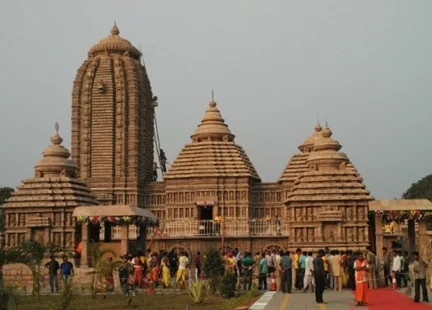
- The Shree Jagannath Temple of Puri is an important Hindu temple dedicated to Lord Jagannath, a form of Vishnu, in Puri in the state of Odisha on the eastern coast of India.
- The present temple was rebuilt from the 10th century onwards, on the site of an earlier temple, and begun by King Anantavarman Chodaganga Deva, first of the Eastern Ganga dynasty.
- The Puri temple is famous for its Annual Ratha yatra, or chariot festival, in which the three principal deities are pulled on huge and elaborately decorated temple cars.
- These gave their name to the English term Juggernaut.
- Unlike the stone and metal icons found in most Hindu temples, the image of Jagannath is made of wood and is ceremoniously replaced every twelve or nineteen years by an exact replica.
Architecture of Jagannath temple:
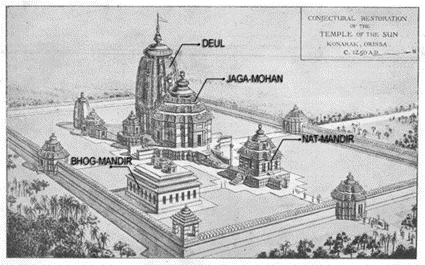
- The temple is built in the Kalinga style of architecture, with the Pancharatha (Five chariots) type consisting of two anurathas, two konakas and one ratha.
- Jagannath temple is a pancharatha with well-developed pagas.
- ‘Gajasimhas’ (elephant lions) carved in recesses of the pagas, the ‘Jhampasimhas’ (Jumping lions) are also placed properly.
- The perfect pancharatha temple developed into a Nagara-rekha temple.
- The temple is built on an elevated platform, as compared to Lingaraja temple and other temples belonging to this type.
- This is the first temple in the history of Kalingaan temple architecture where all the chambers like Jagamohana, Bhogamandapa and Natyamandapa were built along with the main temple.
- There are miniature shrines on the three outer sides of the main temple.
Source: Indian Express
Previous Year Questions
Q.1) The Prime Minister recently inaugurated the new Circuit House near Somnath Temple Veraval. Which of the following statements are correct regarding Somnath Temple? (2022)
- Somnath Temple is one of the Jyotirlinga shrines.
- A description of Somnath Temple was given by Al-Biruni.
- Pran Pratishtha of Somnath Temple (installation of the present day temple) was done by President S. Radhakrishnan.
Select the correct answer using the code given below:
- 1 and 2 only
- 2 and 3 only
- 1 and 3 only
- 1,2 and 3
Q.2) With reference to Chausath Yogini Temple situated near Morena, consider the following statements:
- It is a circular temple built during the reign of Kachchhapaghata Dynasty.
- It is the only circular temple built in India.
- It was meant to promote the Vaishnava cult in the region.
- Its design has given rise to a popular belief that it was the inspiration behind the Indian Parliament building.
Which of the statements given above are correct? (2021)
- 1 and 2
- 2 and 3 only
- 1 and 4
- 2, 3 and 4
Syllabus
- Prelims – Environment and Ecology
Context: With the launch of newer attractions and ecotourism activities, the Amrabad Tiger Reserve in Nallamala forest, Telangana is ready to attract more tourists.
About Amrabad Tiger Reserve:
- The Amrabad Tiger Reserve which is part of the Nallamala Forest track has rich Biological Diversity with several endemic species of flora and fauna.
- This forest tract is home to the largest number of Tigers in Telangana State.
- The hilly terrain of this Tiger Reserve with deep valleys and gorges forms the catchment of the Krishna River.
- This Tiger Reserve (ATR) is one of the largest tiger reserves in India that extends about 2611.4 Sq Km over Nagarkurnool and Nalgonda districts of Telangana State
- Amrabad Tiger Reserve a well-known and well-preserved nature reserve in Nallamala Hills, part of the Eastern Ghats chain.
- This is the second-largest Tiger Reserve in terms of core area but the sixth-largest tiger reserve in terms of total area among 51 Tiger Reserves in India.
- The reserve was notified as a sanctuary in the year 1983 and after the bifurcation of Telugu States in 2014, it was declared as Amarabad Tiger Reserve.
- It lies in the three forest divisions of Amarabad, Achampet in Nagarkurnool district, and Nagarjunsagar division in Nalgonda district.
- Major reservoirs like the Srisailam Dam and Nagarjunsagar Dam are fed by the river Krishna and its several perennial streams that originate in the Tiger Reserve.
- It has a large presence of the Chenchu tribe.
- The Chenchus are Scheduled Tribe in the Indian states of Andhra Pradesh, Telangana, Karnataka, and Odisha.
- Many Chenchus live in the dense Nallamala forest of Andhra Pradesh.
- The Chenchus speak the Chenchu language, a member of the Dravidian language family.
- Chenchu’s relationship with non-tribal people has been largely symbiotic.
Source:The Hindu
Previous Year Questions
Q.1) Among the following Tiger Reserves, which one has the largest area under “Critical Tiger Habitat”? (2020)
- Corbett
- Ranthambore
- Nagarjunsagar-Srisailam
- Sunderbans
Q.2) Which of the following are in Agasthyamala Biosphere Reserve? (2019)
- Neyyar, Peppara and Shendurney Wildlife sanctuaries; and Kalakad Mundanthurai Tiger Reserve
- Mudumalai, Sathyamangalam and Wayanad Wildlife Sanctuaries; and Silent Valley National Park
- Kaundinya, Gundla Brahmeswaram and Papikonda Wildlife Sanctuaries; and Mukurthi National Park
- Kawal and Sri Venkateswara Wildlife Sanctuaries; and Nagarjunasagar Srisailam Tiger Reserve
Syllabus
- Prelims – Current Affairs
Pradhan Mantri Rashtriya Bal Puraskar:
- It is an annual award conferred by the President of India
- It is instituted by the Ministry of Women and Child Development
- Awarded to children in the age group of 5 to 18 years
- In 6 categories namely; Art & Culture, Bravery, Innovation, Scholastic, Social Service and Sports which deserves national recognition.
- Each awardee receives a medal, cash prize of Rs. 1,00,000/-, a certificate and a citation.
- It is in line with the vision of giving children a safe and happy environment every year to honour children for their outstanding performance in different arenas.
- It reflects the commitment to providing children with an atmosphere where they can imbibe good values and principles and become responsible citizens of our country.
- The fields primarily relate to character-building and overall development of society and culture.
Miscellaneous:
- In the freedom struggle of 1857, Veer Surendra Sai fought against the oppression of the British and kept fighting against them till he breathed his last.
Source: PIB
Syllabus
- Prelims – Science and Technology
In News: Five billion people globally are exposed to harmful trans fat, increasing their heart disease and death risk, according to a new report by the World Health Organization (WHO).
- The global health body, in 2018, had advocated some best-practice policies for the global eradication of industrially generated trans fat by 2023.
Transfats:
- Trans fats, also called partially hydrogenated oils, are created when hydrogen is added to vegetable oil to make it more solid.
- The sources of trans fat can be (1) Natural or (2) Artificial.
- Natural trans fats are also called ruminant trans fats, as they are present in small quantities in meat and dairy products obtained form ruminant animals such as cows, sheep and cattle.
- Natural/ruminant trans fat are not generally considered harmful.
- Industrially produced trans fat is usually found in packaged foods, baked items, cooking oils and spreads.
- They are considered even less healthy than saturated fats
- They are generally found in
- Bakery products: Biscuit, fan, rusk, cake etc.
- Fried foods: Bhatura, poori, pakora, bhujiya, fried savoury mixtures (namkeens) etc
- Re-heated oils: Small amounts of trans fats are also formed when the same cooking oil is used for repeated frying; not only at commercial outlets but even at household levels.
Effect
- Trans fat has no known benefit but is associated with huge health risks that can burden health systems
- Trans fat intake is accountable for up to 500,000 early deaths from coronary heart disease annually.
- Consumption of trans fats raises the level of bad LDL-cholesterol, an accepted biomarker of cardiovascular diseases. It has been seen that diets high in trans fat can increase the risk of heart disease by 21 per cent and deaths by 28 per cent.
Eliminating transfat:
- The following are the two best-practice policy options
- mandatory national limit of two grams of industrially produced trans fat per 100 grams of total fat in all foods
- mandatory national ban on the production or use of partially hydrogenated oils (a major source of trans fat) as an ingredient in all foods
- Countdown to 2023 is a WHO report on global trans fat elimination
- FSSAI has employed strategies to achieve its goal of “Freedom from Trans Fat @75.”
Suggestions
- Avoid using “Vanaspati” ghee for any kind of cooking.
- When deep frying the foods (Poori/pakora etc.), do not heat the oil for a very long time. Prefer to not leave the food in the oil for a very long time.
- Do not reheat the oil or re-use the same oil for frying. The oil which has once been used for frying can be used for the preparation of vegetables, curries, dals etc.
- Use smaller vessel (kadhai, etc.) at home for deep frying. This will allow you to do frying using a lesser amount of oil/fat.
- Limit the consumption of baked/processed foods like biscuit/fan, cake, chips, fried savoury mixtures (namkeens, etc.).
Sources: DTE
Previous Year Question
Q1) Regular intake of fresh fruits and vegetables is recommended in the diet since they are a good source of antioxidants .How do antioxidants help a person maintain health and promote longevity? (2011)
- They activate the enzymes necessary for vitamin synthesis in the body and help prevent vitamin deficiency.
- They prevent excessive oxidation of Carbohydrates, fats and proteins in the body and avoid unnecessary wastage of energy.
- They neutralize the free radicals produced in the body during metabolism.
- They activate certain genes in the cells of the body and help delay the ageing process
Syllabus
- Prelims – Science and Technology
In News: The COVID-19 pandemic and the June 2022 floods have compounded Pakistan’s health indicators, a recent study by medical journal The Lancet has found. However, infectious and non-communicable diseases (NCD) were already increasing in the country, as were region-wide disparities.
- Pakistan’s life expectancy has improved from 61.1 years in 1990 to 65.9 years in 2019, with women recording an increase of 8.2 per cent, as compared to 7.6 per cent for men. Balochistan and Khyber Pakhtunkhwa provinces recorded the least improvement in life expectancy.
Non communicable diseases:
- Non-communicable diseases are diseases that are not spread through infection or through other people, but are typically caused by unhealthy behaviours.
- They are the leading cause of death worldwide and present a huge threat to health and development, particularly in low- and middle-income countries.
- Four types of non-communicable diseases account for over two thirds of deaths globally:
- Cardiovascular disease
- Cancers
- Diabetes
- Chronic respiratory diseases
- NCDs share four major risk factors: tobacco use, physical inactivity, the harmful use of alcohol and unhealthy diets.
- More than three-quarters of all NCD deaths, and 86% of the 17 million people who died prematurely, or before reaching 70 years of age, occur in low- and middle-income countries.
- Premature mortality in 2019 was primarily caused by neonatal disorders, followed by ischaemic heart disease, stroke, diarrhoeal diseases and lower respiratory infections
- Iron deficiency has remained the leading cause of years lived with disability for both men and women since 1990.
- Low birthweight, alongside short gestation and particulate matter pollution, has remained the leading contributor to the overall disease burden since 1990.
- NCDs like ischaemic heart disease, stroke, congenital disabilities, cirrhosis and chronic kidney disease were among the 10 leading causes of years of life lost in 2019
Communicable diseases
- Communicable diseases are illnesses that spread from one person to another or from an animal to a person, or from a surface or a food.
- Causes – Pathogens such as viruses, bacteria, and fungi
- Transmission
- direct contact with a sick person
- respiratory droplet spread from a sick person sneezing or coughing
- contact with blood or other body fluids
- breathing in viruses or bacteria in the air
- contact with a contaminated surface or object
- bites from insects or animals that can transmit the disease
- ingestion of contaminated food or water
- Symptoms will vary depending on the disease and on a person’s overall health and immune function.
- Some people will not experience any symptoms. However, they can still transmit the pathogen.
- Some symptoms are a direct result of the pathogen damaging the body’s cells. Others are due to the body’s immune response to the infection.
- Some communicable diseases may be mild, and symptoms pass after a few days. However, some can be serious and potentially life threatening. Symptom severity may vary
- Examples
- Rhinoviruses, Coronaviruses, HIV, Influenza, Salmonella, Tuberculosis, Athlete’s foot, Lyme disease, Plasmodium
Source: PIB
Previous Year Question
Q1) In the context of hereditary diseases, consider the following statements: (2021)
- Passing on mitochondrial diseases from parent to child can be prevented by mitochondrial replacement therapy either before or after in vitro fertilization of egg.
- A child inherits mitochondrial diseases entirely from mother and not from father.
Which of the statements given above is/are correct?
- 1 only
- 2 only
- Both 1 and 2
- Neither 1 nor 2
Syllabus
- Prelims – Science and Technology
In News: Health and Family Welfare Minister said that more than 47 thousand Nikshay Mitra and 8.8 lakh TB patients have been connected through Ni-Kshaya 2.0 portal.
- The Government is making all-out efforts to make the country TB-free by 2025
Ni-kshay Mitra
- The initiative was launched by The President in 2022.
- The initiative aims to ensure additional diagnostic, nutritional, and vocational support to those on TB treatment and encouraged elected representatives, corporates and NGOs to come forward as donors to help the patients towards recovery
- More than 47,000 Nikshay Mitra & 8.8 lakh TB patients have been connected through Ni-Kshaya 2.0 portal
- The initiative ensures three-pronged support includes: Nutritional, Additional diagnostic, and Vocational support.
- Ni-kshay Mitra (Donor) for this programme includes co-operative societies, corporates, elected representatives, individuals, institutions, non-governmental organisations, political parties and partners who can support by adopting the health facilities (for individual donor), blocks/urban wards/districts/States for accelerating the response against TB to complement the government efforts.
NI-KSHAY
- NI-KSHAY-(Ni=End, Kshay=TB) is the web enabled patient management system for TB control under the National Tuberculosis Elimination Programme (NTEP).
- It is developed and maintained by the Central TB Division (CTD), Ministry of Health and Family Welfare, Government of India, in collaboration with the National Informatics Centre (NIC), and the World Health Organization Country office for India.
- Ni-kshay is used by health functionaries at various levels across the country both in the public and private sector, to register cases under their care, order various types of tests from Labs across the country, record treatment details, monitor treatment adherence and to transfer cases between care providers. It also functions as the National TB Surveillance System and enables reporting of various surveillance data to the Government of India.
- The NIKSHA 2.0 portal provides additional patient support to TB patients to take advantage of Corporate Social Responsibility (CSR) opportunities to improve treatment outcomes, enhance community participation and fulfill India’s commitment to TB eradication.
MUST READ Tuberculosis
Source: newsonair
Syllabus
- Mains – GS 2 (Governance)
Context: As the new year dawned, so did a crucial target for India. India had set a target to eliminate measles and rubella (MR) by 2023, having missed the earlier deadline of 2015 as well as the extended deadline of 2020, due to a variety of reasons, exacerbated by disruptions due to the COVID-19 pandemic.
- MR elimination is defined as zero transmission of measles and rubella viruses, evidenced by zero clinical disease, sustained over three years.
About Measles and Rubella:
- Measles: It is a highly contagious viral disease.
- Despite the availability of a safe and effective vaccine, measles remains an important cause of death among young children globally.
- It can also lead to serious adverse outcomes such as blindness, pneumonia and encephalitis.
- Rubella: It is an acute, contagious viral infection.
- While rubella virus infection usually causes a mild fever and rash in children and adults, infection during pregnancy, especially during the first trimester, can result in miscarriage, Fetal death, stillbirth, or infants with congenital malformations, known as congenital rubella syndrome (CRS).
Need for the elimination of Measles and Rubella:
Measles:
- In the pre-vaccination era, while polio paralysed about 1% of all children before the age of five, measles actually killed 1% of all under-five children.
- During measles outbreaks, the case-fatality rate was about 10%-15%.
- Children who recovered would have lost weight as well as the steady momentum of cognitive development and scholastic performance.
- Measles affects the immune system rendering the child vulnerable to other infectious diseases, leading to high mortality over the next two to three years.
Rubella:
- The rubella virus is a slower transmitter and the risk of rubella is extended from childhood through adolescence into the reproductive age range.
- Unfortunately, if a pregnant woman gets infected, the virus tends to cross the placenta and damage the developing foetus’s eyes, brain, heart and other tissues.
- Therefore ,Measles-Rubella elimination is of very high priority.
- The MR vaccine is a combined product, targeting two diseases in one shot.
Challenges associated with the elimination:
- School managements, teachers, children themselves and parents were not informed of the basis of school-based campaigns of Measles-Rubella (MR) vaccination.
- The set targets were not achieved due to gaps in immunisation.
- The COVID-19 pandemic stole two years from the programme.
Government of India Initiatives to eliminate Measles and Rubella:
- National Strategic Plan:
- Measles and rubella (MR) elimination is a national health priority and the government has adopted the National Strategic Plan for Achieving and Sustaining Measles and Rubella Elimination in India .
- Target:
- The Government decided to eliminate measles and rubella from India by the year 2020 having missed the earlier set target of 2015 and the MR elimination target was reset to 2023.
- Campaigns:
- The school-based campaigns of Measles-Rubella (MR) vaccination of children from 5 to 15 years, conducted in all States, in 2017.
- Success was good in a few States, but not in others.
- The country is moving towards the MR elimination goal of achieving and sustaining vaccination coverage of 95% with two doses of a measles- and rubella-containing vaccine at the national and subnational levels.
- Universal Immunisation Programme (UIP):
- India’s Universal Immunisation Programme (UIP) provides free vaccines against 12 life threatening diseases.
- It provides life-saving vaccines to all children across the country free of cost to protect them against Tuberculosis, Diphtheria, Pertussis, Tetanus, Polio, Hepatitis B, Pneumonia and Meningitis due to Haemophilus Influenzae type b (Hib), Measles, Rubella, Japanese Encephalitis (JE) and Rotavirus diarrhoea. (Rubella, JE and Rotavirus vaccine in select states and districts)
Other steps:
- The country is also prioritising continued implementation of key strategies for strengthening surveillance, including the sensitisation of front-line workers, increasing active case searches, expansion of the reporting network, rapid response to outbreaks, and establishing synergistic linkages between MR elimination and other public health priorities, such as health systems strengthening and emergency preparedness and response.
- WHO Country Office for India is supporting the Government of India and state governments towards reaching key elimination targets.
Way Forward:
- It is the high time to further strengthen routine immunisation through intensified efforts to close immunity gaps through Intensified Mission Indradhanush, with a special focus on the first and second dose of measles- and rubella-containing vaccines.
- We can reach MR elimination goals in India if we strengthen surveillance by finding, investigating, and collecting and testing a sample for every suspected case, in each district in every state and UT.
- It is important to provide full support to the ground level staff who implement the programme — the village health nurses, ASHA (accredited social health activists) workers, Anganwadis and ICDS (Integrated Child Development Services) workers.
- While targets will be easier to achieve in States such as Tamil Nadu and Kerala, thanks to the robust immunisation infrastructure, in the other States, additional efforts should be taken to work towards achieving the target.
Source: Indian Express
Syllabus
- Mains – GS 2 International Relations
Context:
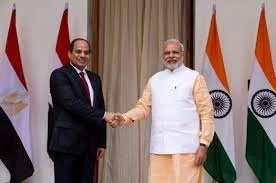
- India and Egypt, two of the world’s oldest civilizations, have enjoyed a history of close contact from ancient times. Ashoka’s edicts refer to his relations with Egypt under Ptolemy-II.
- President of Egypt, Abdel Fattah El-Sisi, will arrive in New Delhi on a three-day visit to India and will be the Chief Guest on India’s 74th Republic Day.
- India and Egypt are celebrating 75 years of establishment of diplomatic relations this year and Egypt has also been invited as a ‘Guest Country’ during India’s Presidency of G-20 in 2022-23.
Bilateral Relations
- India and Egypt enjoy warm and friendly relations marked by civilizational, cultural, and economic linkages and deep-rooted people-to-people ties.
- The two countries work closely at multilateral and international platforms.
- The Egyptian President visited India in October 2015 to participate in the third India Africa Forum Summit and in September 2016 on a State Visit.
Political relations
- The joint announcement of establishment of diplomatic relations at Ambassadorial level was made in 1947.
- With regard to covid pandemic, Egypt dispatched three planes with medical supplies to India in 2021.
- In addition, Embassy of India also signed an agreement to procure 300,000 doses of REMDESEVIR from M/s EVA Pharma, Egypt
- India-LAS Engagement: The 3rd Meeting of the Arab-India Cooperation Forum took place virtually in 2021.
- The discussions focused on issues of mutual concern on both regional and international levels, collaboration in the field of diagnostics and treatment to fight the Covid-19 pandemic and increasing cooperation in the fields of economy, trade and investment, energy and environment, agriculture and food security, science and technology, media, human resource development etc
- Operation Sankalp, which saw the Indian Navy escort oil tankers through the Strait of Hormuz as tensions between Saudi Arabia and Iran escalated, was a good example of India’s mandate in the region moving up from anti-piracy operations to overt protection of national assets and interests.
Trade
- Bilateral trade between India and Egypt achieved a record high of 7.26 billion dollars in 2021-22.
- The trade was fairly balanced, with 3.74 billion Indian exports to Egypt and 3.52 billion imports from Egypt to India.
- The India-Egypt Bilateral Trade Agreement has been in operation since March 1978 and is based on the Most Favoured Nation clause
Investment
- More than 50 Indian companies have invested around 3.15 billion dollars in diverse sectors of the Egyptian economy, including chemicals, energy, textile, garment, agri-business, and retail.
- Egyptian investments in India are to the tune of US$ 37 million which include smart electrometers, car paints, I.T Services, etc.
- The grants-in-aid projects include: Pan Africa Tele-medicine and Tele-education project in Alexandria University, Solar electrification project in Agaween village and Vocational Training Centre for textile technology in Shoubra, Cairo, which have been completed.
Science and Technology
- ‘Science & Technology’ cooperation is implemented through biennial Executive Programmes and Scientific Cooperation Programme between CSIR (India) and NRC (Egypt).
- The first Joint Working Group on Cyber Issues was held in New Delhi in 2016.
- The 4th Joint Committee Meeting on S&T was held in New Delhi in 2017.
- The 2nd ISRO-NARSS JWG was held in Cairo in 2017.
- The India-Egypt Workshops on Agriculture-Biotechnology and Nanotechnology were held in Shillong in 2018 and in Mumbai in 2019 respectively.
- An IT Centre in Al Azhar University, CEIT, is also operational since February 2019.
Defence
- Most of the current defence cooperation is determined by Joint Defence Committee (JDC) activities
- The 8th Joint Defence Committee (JDC) was held in New Delhi in 2018
- The 9th JDC was held in Cairo from in 2019
- IAF pilots had trained Egyptian pilots from 1960s until 1984.
- In the recent past, since 2015, there have been several high-level exchange of visits by defense delegations including the visit of the Minister of Defense of Egypt, General Sedki Sobhi, in 2017 and the visit of Minister of Defense of Indian, Smt. Nirmala Sitharaman, in 2018
- The first ever joint exercise between the special forces of the Indian Army and the Egyptian Army named “Exercise Cyclone-I” is in progress at Jaisalmer in Rajasthan since January 2023.
Suggestions for future:
- Economic partnership – Egypt is in economic flux and requires an urgent infusion of capital to avoid any long-term economic distress.
- Eg Arab Spring, which was backed by people’s anger against economic destitution, cronyism and corruption.
- Russia’s war on Ukraine – led to a commodity crunch, specifically in the agriculture sector like critical wheat imports – India may come out as a viable alternative
- Security perspective – An outreach to Egypt is part of its larger construct of a security architecture in West Asia, particularly the Gulf including UAE, arguably the most powerful leader in the region today
- Energy security is set to become even more precarious over the next few years, India’s naval and aerial military engagements through the mechanism of joint exercises should also see an uptick.
- Trade cooperation – such as the Suez Canal is critical for India as part of international trade systems.
Way forward
- India-Egypt ties in their current stage will require time and honing to lead to more concrete strategic posture.
- The opening with defence exercises is also a good platform to further develop access to fulfil Egypt’s defence requirements.
- While the entire saga of India wanting to sell its HAL Tejas jets to Egypt was an over-ambitious and unrealistic endeavour, promoting defence along with agriculture, Information Technology, amongst others as areas of cooperation can benefit Cairo as it looks to diversify its economic footprint.
Source: Newsonair
Baba’s Explainer – LNG & its climate impact
Syllabus
- GS -3: Science & technology
- GS-3: Economy & Development
- GS-2: International Events
Context: The EU is moving itself off piped Russian gas by rapidly expanding imports of liquified natural gas, much of it fracked in the US.
- As liquified natural gas tankers carrying fracked US gas start to land in northern Germany, climate activists are calling it a major setback in the effort to limit global heating.
- LNG is to compensate for lost Russian gas supplies, with four new terminals set to come online in Germany alone.
- But though touted as a short-term fix, many fear the gas is here for the long haul as the EU becomes the biggest LNG importer in the world.
Read Complete Details on LNG & its climate impact
Practice MCQs
Q.1) With reference to ‘Pradhan Mantri Rashtriya Bal Puraskar’, consider the following statements
- It is given to children between 0-18 years of age
- It is given for bravery achievements only.
Which of the statements given above are incorrect?
- 1 Only
- 2 Only
- Both 1 and 2
- Neither 1 nor 2
Q.2) Which of the following are non-communicable diseases
- Plasmodium
- Diabetes
- Cancer
- Salmonella
- Lyme disease
- Arthritis
Select the correct answer using the code given below.
- 1, 2, 3, 4 only
- 2, 3, 6 only
- 2, 3, 5 only
- 1, 2, 3, 5, 6 only
Q.3) With reference to the Shree Jagannath Temple of Puri, consider the following statements:
- It is the first temple in the history of Kalingaan temple architecture where all the chambers like Jagamohana, Bhogamandapa and Natyamandapa were built along with the main temple
- The temple is built in the Dravidian style of architecture
Which of the statements given above is/are correct?
- 1 only
- 2 only
- Both 1 and 2
- Neither 1 nor 2
Comment the answers to the above questions in the comment section below!!
ANSWERS FOR ’ 24th January 2023 – Daily Practice MCQs’ will be updated along with tomorrow’s Daily Current Affairs.st
ANSWERS FOR 23rd January – Daily Practice MCQs
Q.1) – c
Q.2) – d
Q.3) – c














